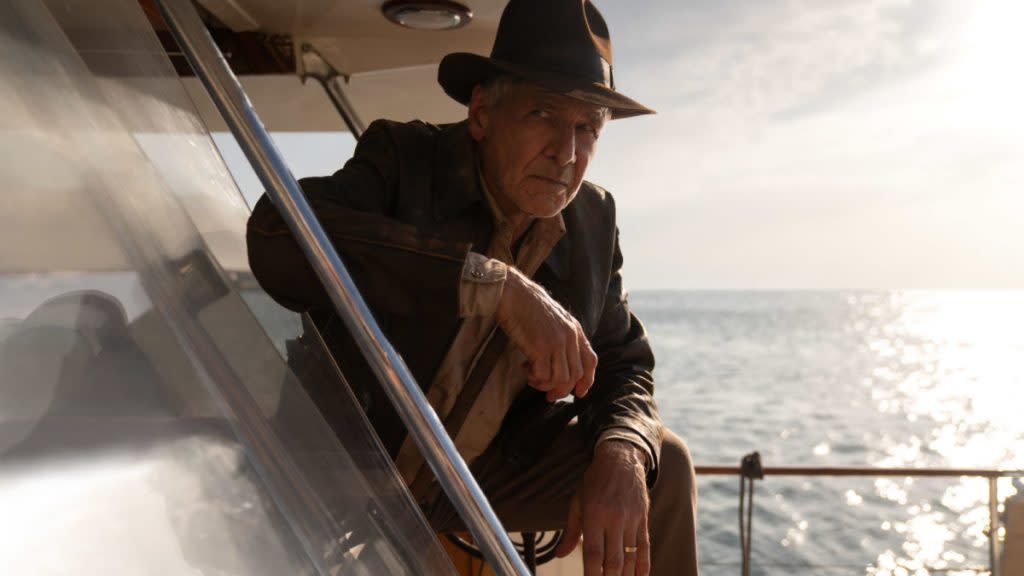James Mangold on Dial of Destiny Exploring Indiana Jones’ Growth

- Oops!Something went wrong.Please try again later.
We won’t be hearing any “old Indy” jokes in Indiana Jones and the Dial of Destiny thanks to Harrison Ford putting his foot down. But this doesn’t mean the upcoming film won’t address the character’s age at all. As it turns out, director James Mangold and co-writers Jez and John-Henry Butterworth came up with more dignified ways of reflecting on Indy’s long, excitement-fueled life before he hangs up the whip and fedora for good this summer. And while speaking with The Hollywood Reporter, Mangold discussed how they set about doing this.
In Dial of Destiny, viewers will catch up with Indiana Jones in his early 70s, which makes him a full decade younger than Ford is in real life. But aside from all the physical ailments that come with aging, it sounds like our hero will be faced with a number of existential dilemmas as he embarks on his final adventure.
“We can’t hide from where we are in our lives — none of us can — and neither can Indiana Jones,” said Mangold. “I wanted to follow Harrison’s own lead and simply deal with it straight on. It’s not just a movie about a hero in his twilight years who is called back into action. It’s more than just that his bones might ache, it’s that his soul might ache, or that some of his optimism or sense fitting into the world might have evaporated. The mistake you can make in movies — and we’ve all seen movies like this — is where someone is of a ripe age, but the entire movie is continuing this charade along with them that they’re not that old.”
RELATED: Indiana Jones Gives ’em Hell in New Dial of Destiny TV Spot
The world that appears in the film—set during the space race of 1969—is also a vastly different place than the one audiences saw depicted in the last installment of the franchise, 2008’s Indiana Jones and the Kingdom of the Crystal Skull. According to Mangold, the shifting zeitgeists will only intensify Indy’s feelings of driftlessness. However, the director was able to look to the previous film for inspiration.
“The first three Indiana Jones movies took place in roughly the same period,” noted Mangold. “They all easily fit with the serialized, theatrical, almost screwball-action style of the movies that were being released in the period they’re set in. The challenge for [Steven Spielberg] on [Crystal Skull], and for me on this one, is: How do you move forward into new decades where the world is no longer seen in such clear demarcations of black and white and good and evil? Where the whole concept of raiding tombs and fighting over relics is looked at in a different way? It’s not about changing the story but allowing the character to experience how the world has changed around him.”
RELATED: Harrison Ford Describes the Tone of Indiana Jones 5
The era’s sense of moral ambiguity will come into play as well. Mangold adds, “our perception of politics is more gray. Who’s a villain? Who are we working with? Who are we fighting against? Proxy wars, all of that. It’s not as simple as the era around World War II. What happens to a hero built for a black-and-white world, when he finds himself in one that is gray? It’s a problem that produces humor, produces contradictions, produces adjustments that this character’s going have to make.”
Indiana Jones and the Dial of Destiny hits theaters on June 30.
What do you think of the filmmakers’ approach to title character? Let us know in the comment section below!
Recommended Reading: The Complete Making of Indiana Jones: The Definitive Story Behind All Four Films
We are a participant in the Amazon Services LLC Associates Program. This affiliate advertising program also provides a means to earn fees by linking to Amazon.com and affiliated sites.

